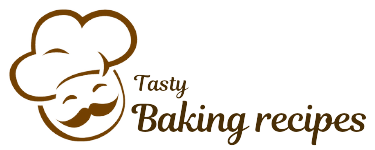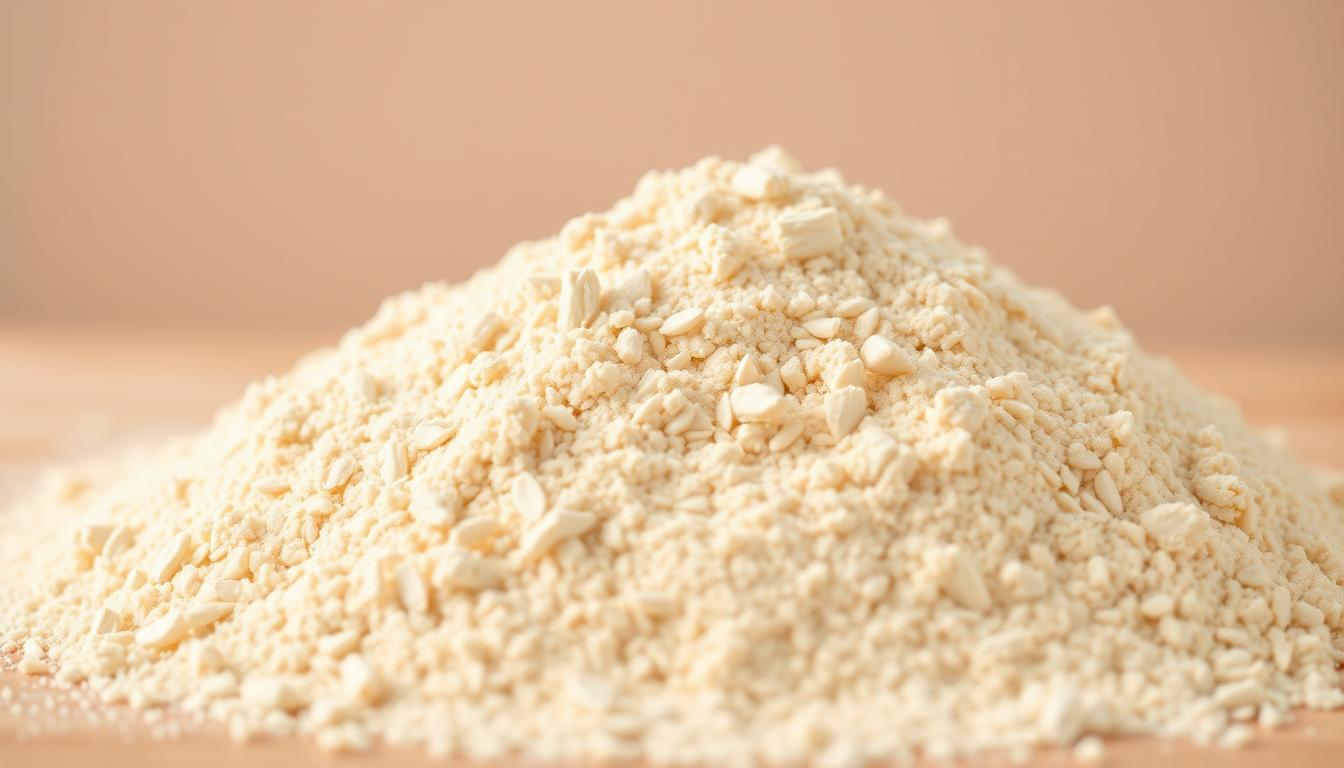Step-by-step guide for baking Einkorn bread.
einkorn bread recipe :
Imagine baking a delicious loaf of bread that’s not only nutritious but also rich in history. You’re about to embark on a journey to create einkorn bread, using an ancient grain that’s gaining popularity among health-conscious bakers.
Einkorn flour, made from one of the oldest varieties of wheat, offers a unique nutritional profile and flavor that’s distinct from modern wheat flours. As you mix the dough, you’ll discover the simplicity and satisfaction of working with this ancient grain.
This comprehensive guide will walk you through the process, from preparing the flour to enjoying your freshly baked loaf. With a tender crumb and nutty flavor, your homemade einkorn bread is sure to become a favorite.
Understanding Einkorn Flour
As you explore the world of ancient grains, you’ll discover the benefits of einkorn flour. Einkorn is known as the oldest variety of wheat, making it an “ancient” grain that has been around for thousands of years.
What is Einkorn Flour?
Einkorn flour comes from an ancient wheat variety that has remained unchanged for thousands of years. Unlike modern wheat, which has undergone extensive hybridization, einkorn still retains its original properties. This ancient grain is believed to have originated in the Tigris-Euphrates region and is possibly referenced in early biblical accounts.
Einkorn wheat has a simpler genetic makeup compared to modern wheat, with only 14 chromosomes. This simplicity contributes to its unique baking characteristics.
Benefits of Baking with Einkorn
Baking with einkorn flour offers several benefits. Here are some key advantages:
- Einkorn flour contains a different type of gluten with a weaker structure, potentially making it easier to digest for those with mild gluten sensitivities.
- It has a naturally sweet, nutty flavor that enhances bread and creates a distinctive taste profile.
- Einkorn flour is nutritionally superior to modern wheat, containing higher levels of protein, essential fatty acids, and various minerals.
When baking with einkorn flour, you’ll notice it absorbs liquids differently and requires less kneading than bread made with modern wheat flour. Understanding these unique properties will help you adjust conventional bread recipes for successful einkorn baking.
Essential Ingredients for Your Einkorn Bread Recipe
Your Einkorn bread recipe’s success depends on the quality of its ingredients. To make a delicious and authentic Einkorn bread, you’ll need to start with the basics.
Basic Ingredients List
The foundation of any good Einkorn bread recipe starts with quality all-purpose Einkorn flour, which behaves differently than conventional flour when forming dough. You’ll also need active dry yeast for leavening, lukewarm water (around 100-105°F) to activate the yeast, and salt to strengthen the gluten structure and control yeast activity. Consider adding a touch of sweetness with honey or maple syrup to feed the yeast and create a tender crumb.
Optional Add-ins for Flavor
To give your Einkorn bread an extra boost of flavor, consider adding optional ingredients like seeds, nuts, dried fruits, or herbs. These add-ins can enhance the flavor profile and texture of your bread, making it even more delicious.
Equipment You’ll Need
To mix and bake your Einkorn bread, you’ll need some essential equipment, including measuring tools, mixing bowls, a wooden spoon, a bread pan or Dutch oven, and parchment paper. A kitchen thermometer is also helpful for checking water temperature and the internal temperature of your finished bread.
Preparing Your Einkorn Bread Dough
Making einkorn bread involves several steps, beginning with dough preparation. To achieve the best results, it’s crucial to understand the characteristics of einkorn flour and how it behaves in the dough.
Mixing the Ingredients
Begin by combining dry ingredients in one bowl and wet ingredients in another. Gradually mix them together, using your fingertips to bring the rest of the flour into the dough mixture. This may require gently kneading the dough a couple of times. Be cautious not to overwork the dough, as Einkorn doesn’t respond well to excessive handling.
- Combine dry and wet ingredients separately before mixing.
- Use a gentle folding motion to preserve the gluten structure.
- Avoid adding extra flour, as Einkorn dough is naturally stickier.
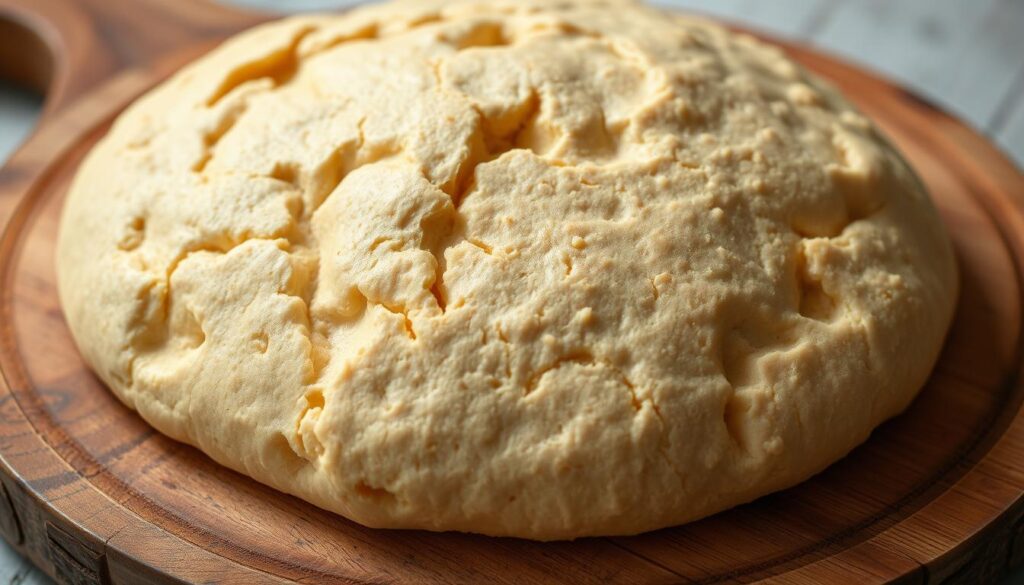
Proper Handling of Einkorn Dough
Einkorn dough benefits from minimal handling. Stop “kneading” once the flour has been combined with the wet ingredients. The dough will likely feel sticky, which is normal. Einkorn flour absorbs liquid slowly, so the dough will absorb more liquid as it rests.
First Rise: What to Expect
Cover the dough with a towel and let it rest at room temperature. The dough should double in size within about an hour, though it can rest for longer periods without issue. Be patient, as the first rise is a critical step in developing the bread’s flavor and texture.
- Place the dough in a lightly oiled bowl, covered with a damp cloth.
- Let it rest until it has roughly doubled in size, typically 1-2 hours.
- Look for visual cues rather than strict timing for the first rise.
Shaping and Second Rise
Once your dough has doubled in size, it’s time to shape it into a loaf. This step is crucial as it determines the final form and texture of your einkorn bread. After the first rise, your dough is ready for shaping.
Shaping Your Loaf
To shape your loaf, start by gently deflating the dough with your fingertips. Lightly flour your hands to prevent sticking, but be cautious not to add too much flour, which can dry out the dough. For a sandwich-style loaf, shape the dough into a rectangle and roll it up tightly, pinching the seam to seal. Place the shaped loaf in a standard-size bread pan that has been greased or lined with parchment paper.
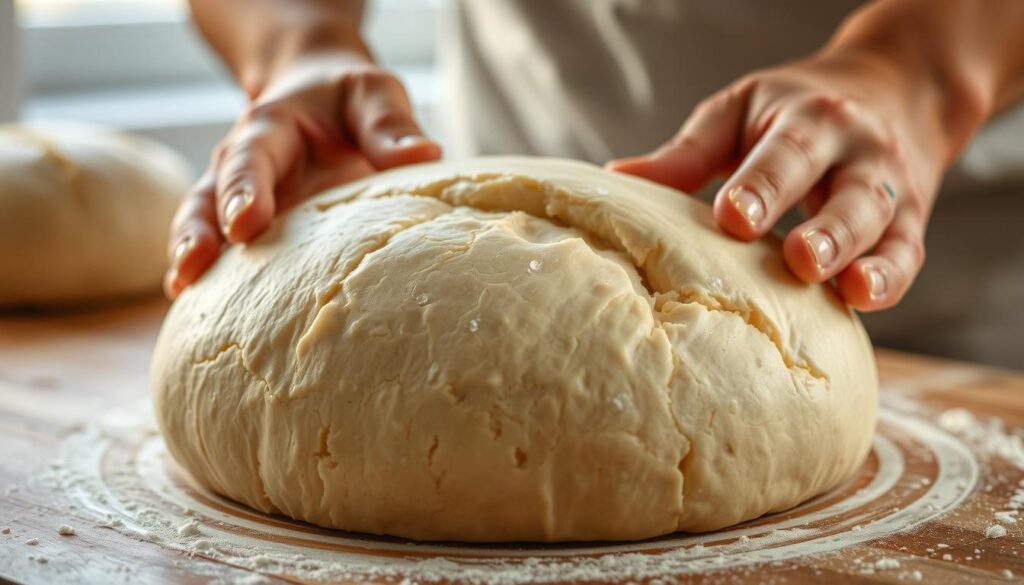
Second Rise Techniques
After shaping, cover the bread with a towel and let it rest for 30 minutes at room temperature. During this second rise, the dough will begin to rise again. To ensure the best results, cover your shaped dough with a damp cloth to prevent it from drying out. The second rise is typically shorter than the first but is crucial for developing the proper texture and volume of your einkorn bread. Your dough is ready for baking when it has visibly expanded and gently springs back when pressed with a fingertip.
- Gently deflate your einkorn dough after the first rise.
- Use minimal flour when shaping to avoid drying out the dough.
- For a rustic boule, use cupped hands to create surface tension without overworking the dough.
Baking the Perfect Einkorn Bread
To achieve the perfect Einkorn bread, it’s crucial to understand the nuances of baking with this ancient flour. The right techniques and conditions can make a significant difference in the final product.
Oven Temperature and Timing
Preheating your oven to the correct temperature is vital for a successful bake. Typically, Einkorn bread recipes call for temperatures between 375-450°F. For sandwich-style Einkorn bread baked in a loaf pan, a moderate oven temperature of 375°F for 35-40 minutes yields the best results. It’s also important to avoid opening the oven door during the first 20 minutes of baking, as this can affect the oven spring.
- Preheat your oven thoroughly to ensure proper oven spring.
- A moderate oven temperature is ideal for sandwich-style Einkorn bread.
- Timing can vary, but generally falls within 35-40 minutes for loaf pans.
Using a Dutch Oven Method
For a crusty artisan-style Einkorn bread, the Dutch oven method is highly recommended. This technique involves preheating the Dutch oven for at least 30 minutes before adding your dough. You then bake the bread covered for about 25-30 minutes, followed by an additional 5-10 minutes uncovered to develop the crust’s color.
- Preheat the Dutch oven for at least 30 minutes.
- Bake covered for 25-30 minutes, then uncovered for 5-10 minutes.
- Use parchment paper to transfer the dough to the Dutch oven.
How to Tell When Your Bread is Done
Determining when your Einkorn bread is done can be done by checking its internal temperature or by tapping on the bottom. The bread is ready when it reaches an internal temperature of 200-205°F or sounds hollow. The crust should be golden brown, though Einkorn flour tends to brown more quickly than modern wheat flour.
- Check the internal temperature for doneness.
- Tap the bottom of the loaf; it should sound hollow.
- Allow the bread to cool completely on a wire rack before slicing.
Variations of Einkorn Bread Recipe
Einkorn bread is versatile, and trying out different recipes can enhance your baking experience. You can experiment with various ingredients and techniques to create unique Einkorn bread variations.
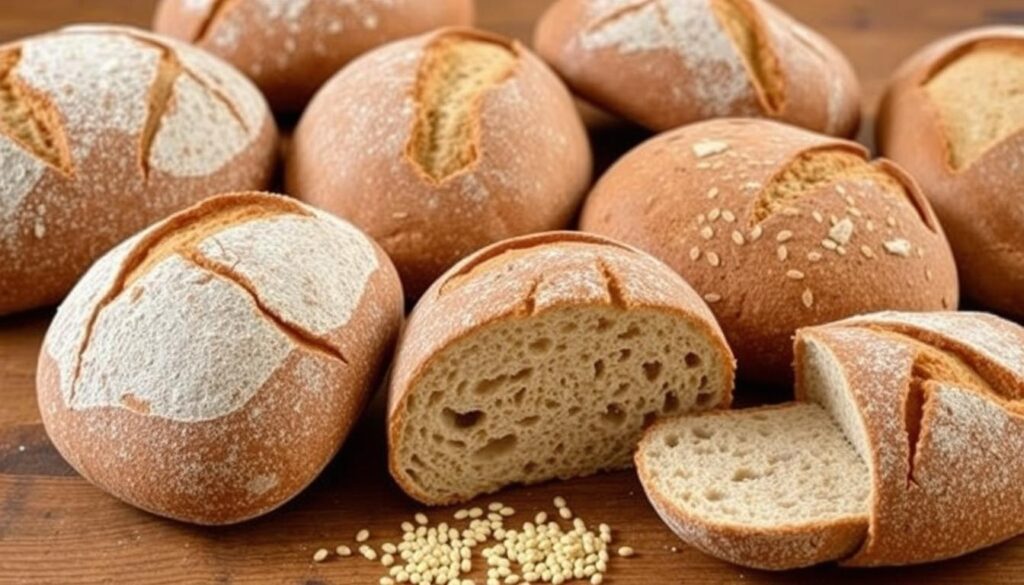
No-Knead Einkorn Bread
No-knead Einkorn bread is perfect for beginners. It requires just mixing the ingredients and allowing time (12-18 hours) to develop gluten and flavor naturally without kneading. This method simplifies the bread-making process and produces a delicious loaf.
Whole Grain Einkorn Bread
Whole grain Einkorn bread uses 100% whole wheat Einkorn flour for maximum nutrition. Although it typically produces a denser loaf than bread made with all-purpose Einkorn flour, it’s a great option for those seeking a nuttier flavor and more fiber. For a lighter whole grain option, try blending whole wheat Einkorn flour with all-purpose Einkorn flour.
Einkorn Sandwich Bread
Einkorn sandwich bread is specially formulated to have a softer, more even crumb that’s perfect for slicing. It typically uses a loaf pan and includes ingredients like milk and butter for tenderness. Reducing the honey to 2 tablespoons and adjusting the flour amount can help achieve the right consistency for sandwiches.
Conclusion
Embracing the art of Einkorn bread baking opens up a realm of possibilities for healthier, tastier bread. As you’ve learned through this guide, mastering Einkorn bread baking takes practice, but the nutritional benefits and unique flavor make it well worth the effort to perfect your einkorn bread recipe.
Remember, Einkorn dough behaves differently than conventional bread dough – it’s stickier, requires less kneading, and benefits from gentler handling. Don’t be discouraged by initial results; each loaf provides valuable experience.
Experiment with various einkorn bread recipes, from no-knead to sourdough, to find your favorite. Store your bread properly, and consider investing in a kitchen scale for precise measurements. As you become more comfortable, explore adding whole grain einkorn flour or other ingredients to create your signature loaf.
Baking Einkorn bread is a rewarding experience that combines great taste with better digestibility. Share your creations and enjoy the delicious results of your efforts.
